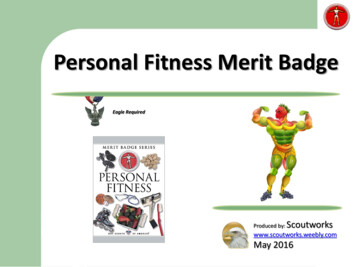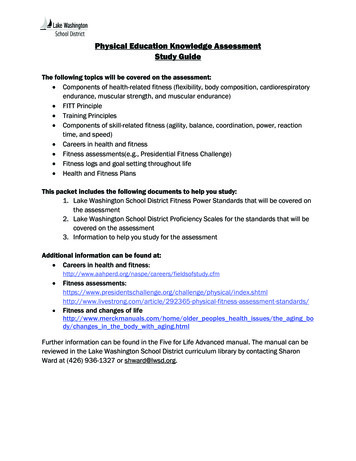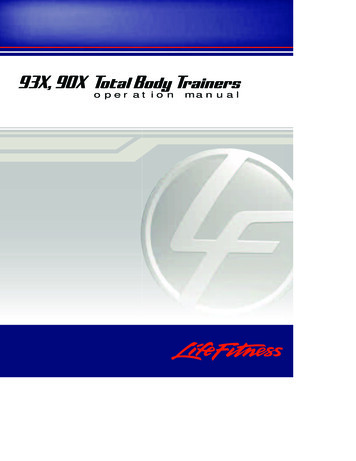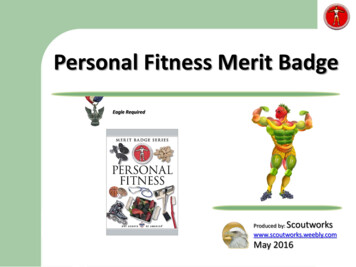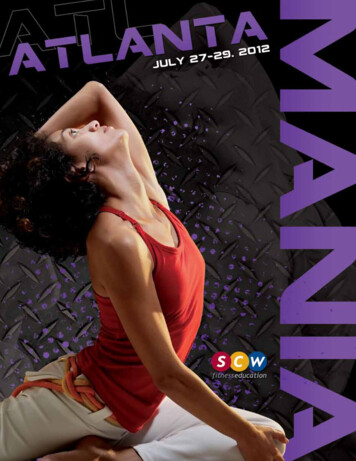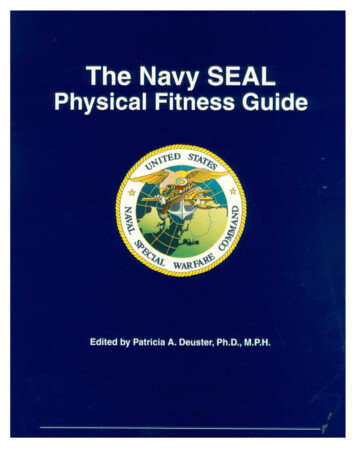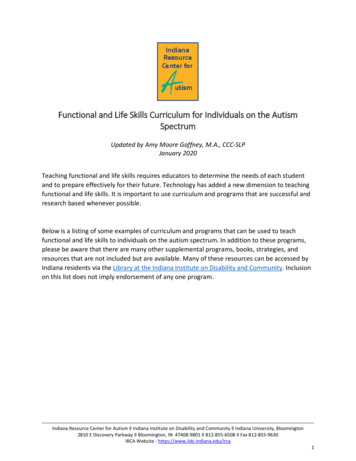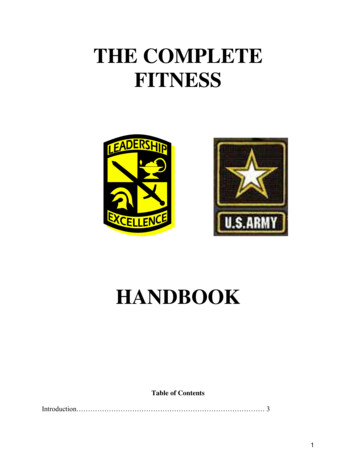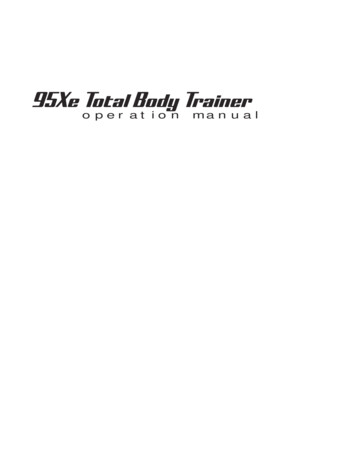
Transcription
Grades 6 to 8 Personal Health SeriesFitnessKidsHealth.org/classroomTeacher’s GuideHelping your students get off the couch and develop a positive approach to fitnesscan contribute to their health and well-being for years to come! The followingactivities will help your students understand the value of fitness and explore variousmethods for pursuing an active lifestyle.This guide includes: Standards Related Links Discussion Questions Activities for StudentsRelated KidsHealth LinksArticles for Kids:Be a Fit Kid Reproducible MaterialsKidsHealth.org/en/kids/fit-kid.htmlWhy Exercise Is dsWhat If I Don’t Like Sports?This guide correlates withthe following National HealthEducation Standards:Students will: Comprehend concepts relatedto health promotion anddisease prevention to enhancehealth. Demonstrate the ability toaccess valid information andproducts and services toenhance health. Demonstrate the ability to usegoal-setting skills to enhancehealth. Demonstrate the ability topractice health-enhancingbehaviors and avoid or reducehealth risks. Demonstrate the ability toadvocate for personal, family,and community g Articles for Teens:Why Exercise Is rts and Exercise ercise gth .htmlDiscussion QuestionsNote: The following questions are written in language appropriate for sharing withyour students.National Health EducationStandards: ndex.htm1.Kicking a game-winning soccer goal not only gives you a rush, it keeps your bodyhealthy! Discuss the benefits of fitness for your body, mind, and emotions.2.Explain how physical activities allow you to interact with people in differentways. How can games, sports, and dance help you to understand people better?3.“Actions speak louder than words.” What do your favorite physical activities sayabout you? 2015 The Nemours Foundation/KidsHealth. Reproduction permitted for individual classroom use.
Grades 6 to 8 Personal Health SeriesFitnessActivities for StudentsNote: The following activities are written in language appropriate for sharing with your students.Getting a Kick Out of Staying in ShapeObjectives:Students will: Develop a kickboxing exercise routine Identify the health benefits of aerobic exerciseMaterials: Computer with Internet accessWord processing program, or pen and paperClass Time:90 minutesActivity:Kickin’ Kelly has hired you to develop the kickboxing routine that she will use in her new DVD. The routine you designshould include common kickboxing moves like kicks and punches. Kickin’ Kelly wants you to send her a proposalincluding the following information: Your kickboxing routine (including a list of the moves, and number of repetitions of each move)The music you recommend to accompany the routineThe necessary equipment for the routineOne paragraph describing the health benefits of kickboxing that Kelly can use on the packaging of the DVDCheck out articles on TeensHealth to help you learn more about kickboxing and the value of aerobic exercise. Thenyou’re ready to write that proposal, and help Kickin’ Kelly kick her viewers into shape!Extensions:1.Have students check out the TeensHealth articles on t’ai chi (TeensHealth.org/en/teens/tai-chi.html), pilates(TeensHealth.org/en/teens/pilates.html), and yoga (TeensHealth.org/en/teens/yoga.html and TeensHealth.org/en/teens/yoga-home.html). Ask them to try one or more of these routines at home for about 20 minutes for 5days after school, then write a brief report on whether they liked doing the routines.2.Have students make their own instructional aerobic exercise videos, individually or in small groups. 2015 The Nemours Foundation/KidsHealth. Reproduction permitted for individual classroom use.
Grades 6 to 8 Personal Health SeriesFitnessFitness IslandObjectives:Students will: Develop a plan for improving fitness Determine activities that address different components of physical fitnessMaterials: Computer with Internet access“Fitness Island” handoutClass Time:90 minutesActivity:As a contestant on a new reality show called “Fitness Island,” you’ll compete in physical tasks to win fame andfortune. Because the physical challenges require strength and endurance, the TV show’s producers want to makesure you’re in top physical shape. You must submit a plan for how you’ll train before arriving on Fitness Island.Include the following elements: Activities that address the three components of a well-balanced exercise routine (aerobic exercise, strengthtraining, flexibility training)A brief explanation of how these activities will improve your fitness levelA calendar that shows a sample week’s activitiesCheck out articles on KidsHealth for guidelines about exercise and fitness, then complete the “Fitness Island”handout.Extension:Have students try out their fitness regimen, then write an essay on how it went.Reproducible MaterialsHandout: Fitness ss/fitness onal/fitness/fitness quiz.pdfQuiz: Answer fitness quiz answers.pdfKidsHealth.org is devoted to providing the latest children’s health information. The site, which is widelyrecommended by educators, libraries, and school associations, has received the “Teachers’ Choice Awardfor the Family” and the prestigious Pirelli Award for “Best Educational Media for Students.” KidsHealth comesfrom the nonprofit Nemours Foundation. Check out www.KidsHealth.org to see the latest additions! 2015 The Nemours Foundation/KidsHealth. Reproduction permitted for individual classroom use.
Personal Health SeriesFitnessName:Date:Fitness IslandInstructions: As a contestant on a new reality show called “Fitness Island,” you’ll compete in physical tasks to win fame and fortune.Because the physical challenges require strength and endurance, the TV show’s producers want to make sure you’re in top physicalshape. Write your plan for how you’ll train before arriving at Fitness Island.Training Plan for Fitness IslandAerobic ExerciseHow will these activities improve your fitness level?Strength TrainingHow will these activities improve your fitness level?Flexibility TrainingHow will these activities improve your fitness level?Sample Training n:Duration:Duration:Duration: 2015 The Nemours Foundation/KidsHealth. Reproduction permitted for individual classroom use.
Personal Health SeriesFitnessName:Date:QuizInstructions: Answer each question.1.What are the three components to a well-balanced exercise routine?2.Teens should get at least3.When you exercise, you burna. endorphinsb. caloriesc. oxygen4.Exercising to maintain a healthy weight decreases a person’s risk of developing certain illnesses, such as:5.minutes of moderate to vigorous physical activity each day.as fuel.is any type of exercise that gets the heart pumping and the muscles using oxygen.6.Which burns more energy when a person is at rest — muscle or fat?7.List three benefits of strength training.8.9.is a condition that occurs when a person loses more fluids than he or she takes in.How does weight-bearing exercise (like running or brisk walking) help prevent osteoporosis?10. True or false: Walking or bicycling to school counts as exercise. 2015 The Nemours Foundation/KidsHealth. Reproduction permitted for individual classroom use.
Personal Health SeriesFitnessQuiz Answer Key1.What are the three components to a well-balanced exercise routine?aerobic exercise, strength training, and flexibility training602.Teens should get at least3.When you exercise, you burna. endorphinsb. caloriesc. oxygen4.Exercising to maintain a healthy weight decreases a person’s risk of developing certain illnesses, such as:type 2 diabetes or high blood pressure5.Aerobic exerciseminutes of moderate to vigorous physical activity each day.as fuel.is any type of exercise that gets the heart pumping and the muscles using oxygen.muscle6.Which burns more energy when a person is at rest — muscle or fat?7.List three benefits of strength training.Any three of the following: increase your endurance and strength for sports and fitness activities; develop your ability tofocus and concentrate; reduce body fat; increase muscle mass; help burn more calories when at rest; reduce risk of injuries byprotecting bones and joints; preventing long-term medical problems like osteoporosis8.9.Dehydrationis a condition that occurs when a person loses more fluids than he or she takes in.How does weight-bearing exercise (like running or brisk walking) help prevent osteoporosis?This type of exercise helps to keep bones strong.10. True or false: Walking or bicycling to school counts as exercise. 2015 The Nemours Foundation/KidsHealth. Reproduction permitted for individual classroom use.
A brief explanation of how these activities will improve your fitness level A calendar that shows a sample week’s activities Check out articles on KidsHealth for guidelines about exercise and fitness, then complete the “Fitness Island” handout. Extension: Have students try out their fitn
